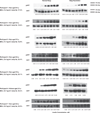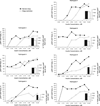Impaired insulin signaling in human adipocytes after experimental sleep restriction: a randomized, crossover study
- PMID: 23070488
- PMCID: PMC4435718
- DOI: 10.7326/0003-4819-157-8-201210160-00005
Impaired insulin signaling in human adipocytes after experimental sleep restriction: a randomized, crossover study
Abstract
Background: Insufficient sleep increases the risk for insulin resistance, type 2 diabetes, and obesity, suggesting that sleep restriction may impair peripheral metabolic pathways. Yet, a direct link between sleep restriction and alterations in molecular metabolic pathways in any peripheral human tissue has not been shown.
Objective: To determine whether sleep restriction results in reduced insulin sensitivity in subcutaneous fat, a peripheral tissue that plays a pivotal role in energy metabolism and balance.
Design: Randomized, 2-period, 2-condition, crossover clinical study.
Setting: University of Chicago Clinical Resource Center.
Participants: Seven healthy adults (1 woman, 6 men) with a mean age of 23.7 years (SD, 3.8) and mean body mass index of 22.8 kg/m(2) (SD, 1.6).
Intervention: Four days of 4.5 hours in bed or 8.5 hours in bed under controlled conditions of caloric intake and physical activity.
Measurements: Adipocytes collected from subcutaneous fat biopsy samples after normal and restricted sleep conditions were exposed to incremental insulin concentrations. The ability of insulin to increase levels of phosphorylated Akt (pAkt), a crucial step in the insulin-signaling pathway, was assessed. Total Akt (tAkt) served as a loading control. The insulin concentration for the half-maximal stimulation of the pAkt-tAkt ratio was used as a measure of cellular insulin sensitivity. Total body insulin sensitivity was assessed using a frequently sampled intravenous glucose tolerance test.
Results: The insulin concentration for the half-maximal pAkt-tAkt response was nearly 3-fold higher (mean, 0.71 nM [SD, 0.27] vs. 0.24 nM [SD, 0.24]; P = 0.01; mean difference, 0.47 nM [SD, 0.33]; P = 0.01), and the total area under the receiver-operating characteristic curve of the pAkt-tAkt response was 30% lower (P = 0.01) during sleep restriction than during normal sleep. A reduction in total body insulin sensitivity (P = 0.02) paralleled this impaired cellular insulin sensitivity.
Limitation: This was a single-center study with a small sample size.
Conclusion: Sleep restriction results in an insulin-resistant state in human adipocytes. Sleep may be an important regulator of energy metabolism in peripheral tissues.
Primary funding source: National Institutes of Health.
Conflict of interest statement
Figures




Comment in
-
A new challenge to widely held views on the role of sleep.Ann Intern Med. 2012 Oct 16;157(8):593-4. doi: 10.7326/0003-4819-157-8-201210160-00016. Ann Intern Med. 2012. PMID: 23070494 No abstract available.
References
-
- Hobson JA, Pace-Schott EF. The cognitive neuroscience of sleep: neuronal systems, consciousness and learning. Nat Rev Neurosci. 2002;3:679–693. [PMID: 12209117] - PubMed
-
- Stickgold R. Sleep-dependent memory consolidation. Nature. 2005;437:1272–1278. [PMID: 16251952] - PubMed
-
- Beihl DA, Liese AD, Haffner SM. Sleep duration as a risk factor for incident type 2 diabetes in a multiethnic cohort. Ann Epidemiol. 2009;19:351–357. [PMID: 19362278] - PubMed
Publication types
MeSH terms
Substances
Grants and funding
- P60-DK020595/DK/NIDDK NIH HHS/United States
- P50 HD057796/HD/NICHD NIH HHS/United States
- 5T32-HL07909/HL/NHLBI NIH HHS/United States
- R01-HL086459/HL/NHLBI NIH HHS/United States
- UL1-RR024999/RR/NCRR NIH HHS/United States
- R01 HL086459/HL/NHLBI NIH HHS/United States
- P50 HD-057796/HD/NICHD NIH HHS/United States
- UL1 RR024999/RR/NCRR NIH HHS/United States
- P01-AG11412/AG/NIA NIH HHS/United States
- T32 HL007909/HL/NHLBI NIH HHS/United States
- P41 RR013642/RR/NCRR NIH HHS/United States
- P60 DK020595/DK/NIDDK NIH HHS/United States
- P01 AG011412/AG/NIA NIH HHS/United States
LinkOut - more resources
Full Text Sources
